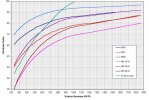Are Rc numbers the be-all/end all? Of course not.
What is the relationship between geometry and HRC numbers?
As you know, it's complicated, and varies from knife to knife and perhaps moreso between different steels. Obviously, I don't run big choppers with the same edge thickness and hardness as super-thin slicers made of the same alloy. That would be dumb.
I can control geometry within a thousandth of an inch fairly easily. That's my job as a grinder/sparkmaker.
But I'm just not set up to control my entire HT process and test it to anywhere
near that degree of accuracy... and very few small shops are.
Peters'
is set up for that, and they Rockwell-test every one of my blades at least twice to be sure. That lends a great deal of peace-of-mind to me and my clients.
"Ballpark" hardness values based on datasheets, guesswork and
several other factors (austenizing temp, color charts, homebuilt forges, quenchant speed, calibrated eyeballs, toaster-oven tempering cycles etc - every one of which is very likely to be off by who-knows-how-much) is simply not good enough for me. There's a certain amount of wiggle-room between optimum and half-vast, but I prefer optimum. All that stuff
usually works out fairly well, but it *could* add up to a total failure, in a worst-case scenario.
JT got no time for that.
That's why they invented Rockwell testers in the first place... as a major step of quality control to see if everything
probably went right, or
might be horribly wrong.

